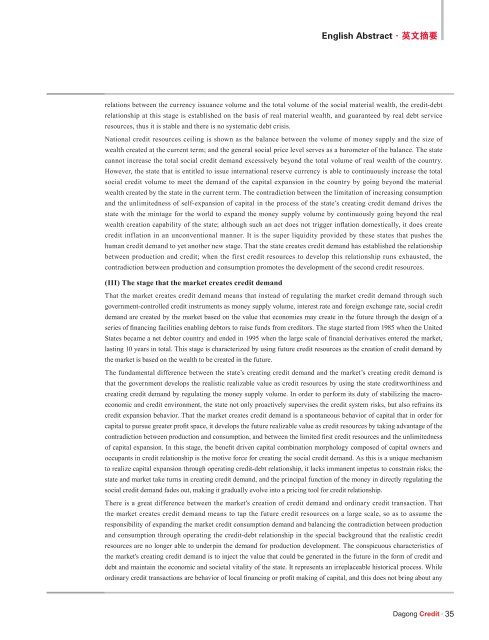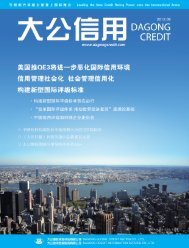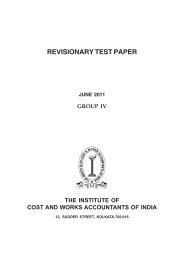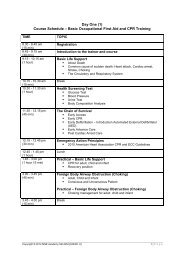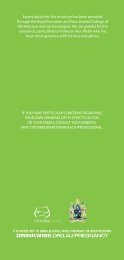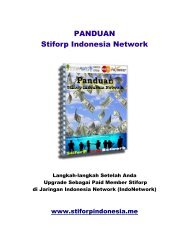Industry Info·行业资讯 - Amazon Web Services
Industry Info·行业资讯 - Amazon Web Services
Industry Info·行业资讯 - Amazon Web Services
Create successful ePaper yourself
Turn your PDF publications into a flip-book with our unique Google optimized e-Paper software.
English Abstract· 英 文 摘 要<br />
relations between the currency issuance volume and the total volume of the social material wealth, the credit-debt<br />
relationship at this stage is established on the basis of real material wealth, and guaranteed by real debt service<br />
resources, thus it is stable and there is no systematic debt crisis.<br />
National credit resources ceiling is shown as the balance between the volume of money supply and the size of<br />
wealth created at the current term; and the general social price level serves as a barometer of the balance. The state<br />
cannot increase the total social credit demand excessively beyond the total volume of real wealth of the country.<br />
However, the state that is entitled to issue international reserve currency is able to continuously increase the total<br />
social credit volume to meet the demand of the capital expansion in the country by going beyond the material<br />
wealth created by the state in the current term. The contradiction between the limitation of increasing consumption<br />
and the unlimitedness of self-expansion of capital in the process of the state’s creating credit demand drives the<br />
state with the mintage for the world to expand the money supply volume by continuously going beyond the real<br />
wealth creation capability of the state; although such an act does not trigger inflation domestically, it does create<br />
credit inflation in an unconventional manner. It is the super liquidity provided by these states that pushes the<br />
human credit demand to yet another new stage. That the state creates credit demand has established the relationship<br />
between production and credit; when the first credit resources to develop this relationship runs exhausted, the<br />
contradiction between production and consumption promotes the development of the second credit resources.<br />
(III) The stage that the market creates credit demand<br />
That the market creates credit demand means that instead of regulating the market credit demand through such<br />
government-controlled credit instruments as money supply volume, interest rate and foreign exchange rate, social credit<br />
demand are created by the market based on the value that economies may create in the future through the design of a<br />
series of financing facilities enabling debtors to raise funds from creditors. The stage started from 1985 when the United<br />
States became a net debtor country and ended in 1995 when the large scale of financial derivatives entered the market,<br />
lasting 10 years in total. This stage is characterized by using future credit resources as the creation of credit demand by<br />
the market is based on the wealth to be created in the future.<br />
The fundamental difference between the state’s creating credit demand and the market’s creating credit demand is<br />
that the government develops the realistic realizable value as credit resources by using the state creditworthiness and<br />
creating credit demand by regulating the money supply volume. In order to perform its duty of stabilizing the macroeconomic<br />
and credit environment, the state not only proactively supervises the credit system risks, but also refrains its<br />
credit expansion behavior. That the market creates credit demand is a spontaneous behavior of capital that in order for<br />
capital to pursue greater profit space, it develops the future realizable value as credit resources by taking advantage of the<br />
contradiction between production and consumption, and between the limited first credit resources and the unlimitedness<br />
of capital expansion. In this stage, the benefit driven capital combination morphology composed of capital owners and<br />
occupants in credit relationship is the motive force for creating the social credit demand. As this is a unique mechanism<br />
to realize capital expansion through operating credit-debt relationship, it lacks immanent impetus to constrain risks; the<br />
state and market take turns in creating credit demand, and the principal function of the money in directly regulating the<br />
social credit demand fades out, making it gradually evolve into a pricing tool for credit relationship.<br />
There is a great difference between the market's creation of credit demand and ordinary credit transaction. That<br />
the market creates credit demand means to tap the future credit resources on a large scale, so as to assume the<br />
responsibility of expanding the market credit consumption demand and balancing the contradiction between production<br />
and consumption through operating the credit-debt relationship in the special background that the realistic credit<br />
resources are no longer able to underpin the demand for production development. The conspicuous characteristics of<br />
the market's creating credit demand is to inject the value that could be generated in the future in the form of credit and<br />
debt and maintain the economic and societal vitality of the state. It represents an irreplaceable historical process. While<br />
ordinary credit transactions are behavior of local financing or profit making of capital, and this does not bring about any<br />
Dagong Credit<br />
35


